|
|
|||
|
(Back to Preceding Week; on to Next Week) |
|
|
|
ORCHARD ORIOLE
Mist nets are like giant hair nets strung between two poles to capture wild birds. Usually about 42 feet long by seven feet tall, they are nearly invisible when erected in a shady place--hence the name "mist nets." After deploying our nets at sunrise, we never know what we might find as we make net rounds at regular intervals during the day. Such was the case on 18 June when not far from our old farmhouse at Hilton Pond Center we saw a yellow-green bird snared in a net intended to catch hummingbirds. The bird was similar in color to a winter-plumage female American Goldfinch, but even from a distance we could tell it was considerably larger than that. As we approached the net, we were pleased to find we had captured a Neotropical migrant relatively common to the Carolina Piedmont but seldom banded at Hilton Pond: A female Orchard Oriole (below).
All text & photos © Hilton Pond Center Orchard Orioles, Icterus spurius, are the southern counterpart of the more commonly known Baltimore Oriole, I. galbula. Orchard Orioles breed in the U.S. east of the Rockies while Baltimore Orioles nest primarily in the northeastern and central U.S. and southern Canada—rarely at higher elevations in the Carolinas. Because the female Orchard Oriole we netted this week had a brood patch--and because we have caught recent fledglings in past years--we conclude the species breed at or very near the Center, even though we've not found a nest locally.
Female and recently fledged male Orchard Orioles are pale greenish-yellow (above), with grayish wings and two white wingbars. The belly and vent feathers are also yellow (below)--one way to differentiate grayer-bellied female Baltimore Orioles. On their wintering grounds the young males develop a black throat and mask and return looking like the bird in the photo below--taken from a scan of a slide we made at Hilton Pond Center back in 1984.
The male's "immature" plumage is retained during its first two breeding seasons, when its belly, rump, and upper wingbar begin changing in spotty fashion to a brick red color. This change in coloration is foretold in the bird above by a single "adult" feather in his upper wingbar.
Alexander Wilson portrayed all the various color variations by age and sex in his splendid Orchard Oriole plate (above), published in 1808. As depicted so vividly by Wilson, an adult male Orchard Oriole has exchanged his immature yellow head, bib, back and tail feathers for jet black, which is also the new dominat color of his wings. Although second-year males may be able to breed, they don't acquire full adult plumage until their third spring. In his tableau above Wilson includes two Orchard Oriole eggs--perhaps in recognition of egg-collecting hobbyists who were quite active in his day.
About 30 years after Wilson, John James Audubon painted his own mixed group of Orchard Orioles, which he said was also called "Hang-nest." He renders the birds with accuracy in a Honeylocust tree and correctly shows the grass-woven nest as a sort of hanging basket--not the deeper sock-like structure of the Baltimore Oriole. Orchard Orioles typically nest in trees and tall shrubs in areas as varied as old orchards and suburban neighborhoods; in the Mississippi Delta they even build among marsh reeds in the style of Red-winged Blackbirds. Orchard Orioles are known to be semi-colonial; one seven-acre site in Louisiana had 114 nests, 80 of them in oaks! Curiously, numerous observers have noted that Orchard Orioles often nest in the same tree as a pair of Eastern Kingbirds, but no one seems to have offered an explanation for this juxtaposition. We suspect the orioles benefit from kingbird aggression against potential nest predators. In the Carolinas, some Orchard Orioles arrive ahead of most spring migrants, often showing up in late March; our earliest at the Center was 20 April 1995. Despite their colorful appearance, Orchard Orioles are members of the same Blackbird Subfamily (Icterinae) as Common Grackles and Brown-headed Cowbirds. Orchard Orioles may be in decline from habitat loss here and in the tropics and because their single broods are parasitized heavily by pesky cowbird relatives. We've never seen Orchard Orioles in big numbers here at Hilton Pond Center--the female we caught this week was only our 52nd banded since 1982--but that may be due in part to their usual preference for hanging out in the canopy and subcanopy rather than near ground level where we place our nets. All text & photos © Hilton Pond Center
Comments or questions about this week's installment?
Thanks to the following fine folks for recent gifts in support of Hilton Pond Center for Piedmont Natural History and/or Operation RubyThroat: The Hummingbird Project. Your tax-deductible contributions allow us to continue writing, photographing, and sharing "This Week at Hilton Pond." (Please see Support if you'd like to make a gift of your own.)
IMPORTANT NOTE: If you ever shop on-line, you may be interested in becoming a member of iGive, through which nearly 700 on-line stores from Barnes and Noble to Lands' End will donate a percentage of your purchase price in support of Hilton Pond Center and Operation RubyThroat. We've just learned that for every new member who signs up and makes an on-line purchase within 45 days iGive will donate an ADDITIONAL $5 to the Center. Please sign up by going to the iGive Web site. It's a painless and important way for YOU to support our work in conservation, education, and research. "This Week at Hilton Pond" is written & photographed You may wish to consult our Index of all nature topics covered since February 2000. You can also use our on-line Hilton Pond Search Engine at the bottom of this page. For a free, non-fattening, on-line subscription to |


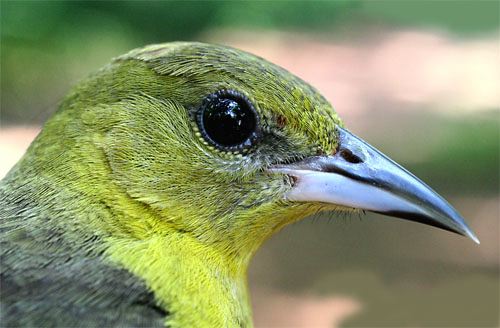

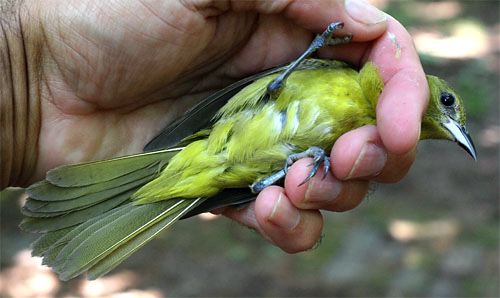
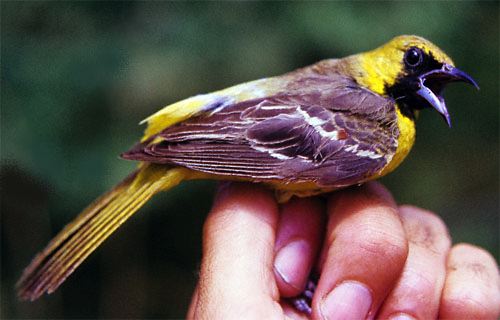
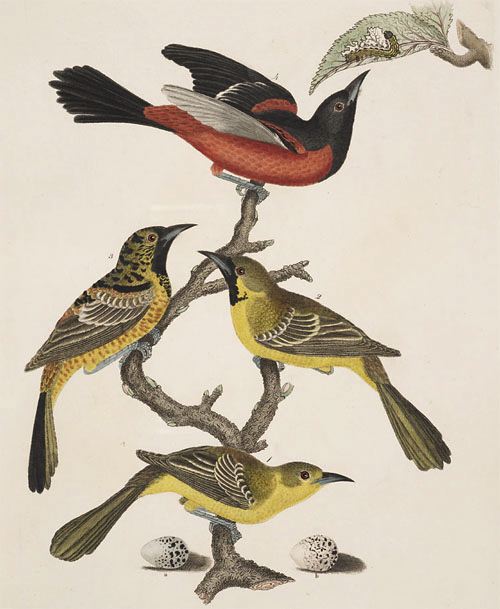
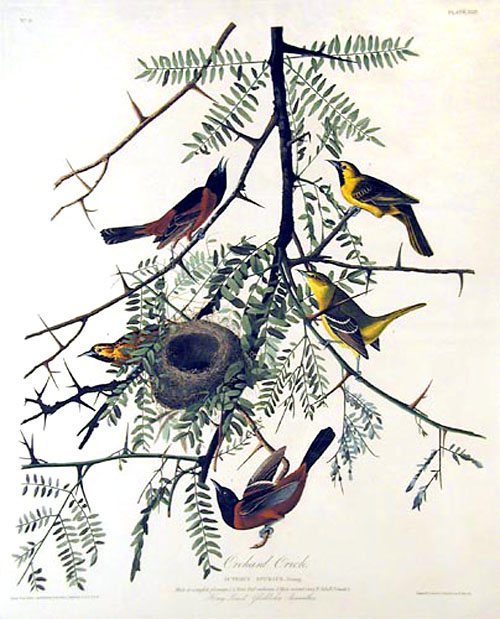
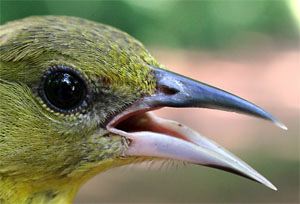 They also depart on their southward trip rather early, heading out for Central America and northwestern South America as early as mid-July. Here on the breding grounds Orchard Orioles use their inch-long, pointed, bicolored bills (left) to capture insects and caterpillars, only occasionally eating fruit such as cherries, pokeberries, and wild grapes; they seldom visit sugar water feeders provided for hummingbirds or Baltimore Orioles. Their diet changes somewhat across their wintering range in the tropics where Orchard Orioles are important pollinators for various tree species whose flowers provide nectar and fruit.
They also depart on their southward trip rather early, heading out for Central America and northwestern South America as early as mid-July. Here on the breding grounds Orchard Orioles use their inch-long, pointed, bicolored bills (left) to capture insects and caterpillars, only occasionally eating fruit such as cherries, pokeberries, and wild grapes; they seldom visit sugar water feeders provided for hummingbirds or Baltimore Orioles. Their diet changes somewhat across their wintering range in the tropics where Orchard Orioles are important pollinators for various tree species whose flowers provide nectar and fruit.

 Please report your
Please report your
